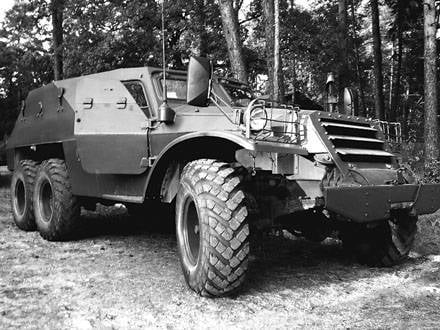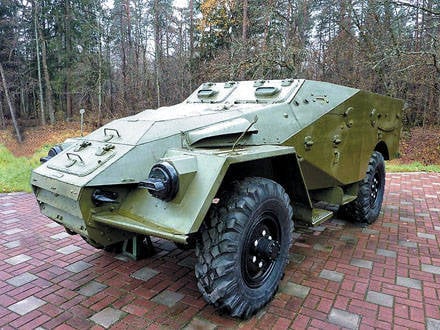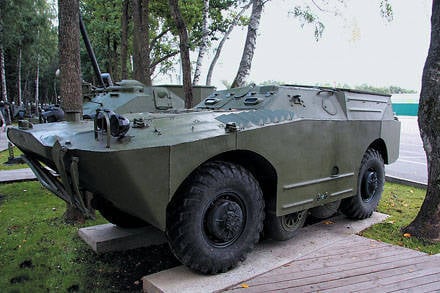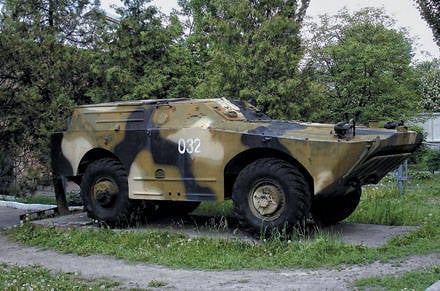Steel Scouts
 Since time immemorial, intelligence has been said to be the eyes and ears of the army, that it is the point of the sword of the army. This popular expression did not become outdated in the 21st century. Scouts are always ahead. Today, military leaders pay as much attention to intelligence as, for example, in World War I. Then, however, scouts often moved on foot or, at best, on horseback. In the years of the Great Patriotic War, scouts developed motorcycles, trucks, and even armored cars. But today, such a technique would hardly suit a military intelligence service. The fact is that it is good to hear and to see far away - already a little. To successfully cope with dozens of new challenges, with changed responsibilities, the intelligence officers needed a special machine that fully meets the level of technology of our time.
Since time immemorial, intelligence has been said to be the eyes and ears of the army, that it is the point of the sword of the army. This popular expression did not become outdated in the 21st century. Scouts are always ahead. Today, military leaders pay as much attention to intelligence as, for example, in World War I. Then, however, scouts often moved on foot or, at best, on horseback. In the years of the Great Patriotic War, scouts developed motorcycles, trucks, and even armored cars. But today, such a technique would hardly suit a military intelligence service. The fact is that it is good to hear and to see far away - already a little. To successfully cope with dozens of new challenges, with changed responsibilities, the intelligence officers needed a special machine that fully meets the level of technology of our time.It just so happened that intelligence was and remains one of the main professions of an armored car. Army reconnaissance armored vehicles go the very first, go to the unknown, go, every second risking to meet with an enemy ambush or mines. Often it happens. But the scouts simply have no other way. Today, the “steel mule” for intelligence officers is an armored reconnaissance and patrol vehicle (BRDM), originally the BRDM-1, and then the BRDM-2 and the BRDM-3, intended for conducting tactical reconnaissance, combat and sentry guard, and combat reconnaissance and sabotage groups the adversary. Small in size, fast, they have various special equipment and are able to overcome water obstacles on the move. These machines have high dynamic qualities, large power reserve, increased maneuverability.
Wheeled armored vehicles in the Soviet Armed Forces have traditionally been used for reconnaissance, communications, the task of field guards and transportation commanders. After the end of the Great Patriotic War, service in military intelligence continued to carry the tested BA-64 armored car. From 1950 onwards, the BTR-40 light armored personnel carrier, an open-top biaxial all-wheel-drive armored vehicle based on the GAZ-63 truck, began to arrive in the army.
The sharp increase in mobility and technical equipment of the ground forces required the creation of a specialized, armored reconnaissance and patrol vehicle of a new generation, radically different from both the wheeled armored vehicles of the World War II period (BA-64) and the wheeled armored personnel carriers BTR-40 and BTR-152, designed immediately after its completion. A new combat vehicle had to meet the requirements of the time, including to have:
- by buoyancy, overcoming without preliminary preparation wide water barriers with a wave height of up to half a meter;
- increased speed;
- high maneuverability (in particular, there was a demand for overcoming ditches and trenches up to 1,2 meters wide);
- have significant internal volumes to accommodate a group of intelligence officers, necessary weapons and special equipment.
The development of the BRDM in the Soviet Union began at the end of 1954 at the design bureau of the Gorky Automobile Plant under the leadership of V. A. Dedkov. V.K. Rubtsov was appointed the leading designer of the new combat vehicle. This design team already had significant experience in the creation of wheeled armored vehicles (BTR-40 and its modifications), as well as floating vehicles. The designers were faced with the task of creating a floating modification of the light armored personnel carrier BTR-40, well-developed and fully mastered in the troops, which was in service with reconnaissance battalions of motorized rifle and tank formations of the Soviet army. Initially, this corresponded to the designation of the new vehicle under development - BTR-40 P (P - floating).

However, in the course of work, in order to ensure buoyancy and increase the patency of the base machine, a very large number of changes were required in its design. It became obvious that it would not be possible to restrict ourselves to simply modifying an existing product, so it was decided to make a completely new machine that has no analogues in the world. The demands of the military to overcome ditches and trenches, due to the experience of the past war, when these very common obstacles on the battlefield sometimes delayed the advance of wheeled combat vehicles for a long time, led to the development of a unique chassis consisting of a four-wheel main propulsion unit and four additional wheels mounted in the central part of the machine ( two on each side), which served to overcome the trenches. During overcoming obstacles additional wheels with the help of a hydraulic mechanism could be lowered and set in motion with the help of a special transmission. Thus, the BRDM transformed from a four-wheel into an eight-wheel car. The main wheels had a centralized booster system, previously tested on armored personnel carriers BTR-40 and BTR-152.
Initially, it was intended to use a traditional propeller for water navigation. However, it was further decided to use a water cannon developed for the PT-76 amphibious tank. Such a mover was more compact and tenacious. In addition, a similar water can be used to pump water from the body of the machine. Increased maneuverability on the water - the turning radius was only 1,5 m.
The first prototype of the BRDM was manufactured in February 1956 of the year. In the future, he was joined by several more machines subjected to very rigorous testing (in particular, one of the BRDM forced to swim the Kerch Strait). At the end of 1957, the Gorky Automobile Plant produced an experimental series of BRDM. After conducting military tests, an armored reconnaissance and patrol vehicle BRDM was adopted by the Soviet Army by order of the USSR Defense Minister from 10 in January 1958 of the year and launched into serial production, which lasted until the 1966 of the year.
In the design of the BRDM, a schematic layout and the main units of the BTR-40 armored personnel carrier were used. For the car was chosen layout with a front-engine compartment. The control unit and the troop compartment were combined and were located in the middle and aft parts of the hull. Installing the engine in the elongated front of the hull provided for dismounting of the crew members through the two stern doors, however, the visibility from the driver’s position was degraded.
The BRDM had a hermetic bearing body, with a welded structure, made of armor rolled sheets with thickness 6, 8 and 12 mm. The pontoon shape of the hull, carefully thought out from the point of view of hydrodynamics, provided the car with minimal resistance when moving afloat. In general, the armored body provided protection against bullets and fragments of artillery shells and small-caliber mines.
An armored cabin was installed and welded on top of the hull, which housed the crew of the vehicle and the troops.
In the middle part of the corps there was a command compartment and a combat compartment combined with it, occupying the middle and rear parts of the vehicle. The power plant compartment and the control compartment was divided by a partition.

In the first mass-produced vehicles, the department of command and landing was located in an open-top armored wheelhouse, which was soon closed with an armored roof with two hatches for the landing and exit of the driver and commander. Another bivalve hatch was available in the aft cabin. The top frontal sheet had an angle of inclination 85 degrees. On the roof of the nose of the case were input and output louvers of the engine cooling system.
The fighting compartment occupied the middle and aft parts of the corps. In the department of management, located in the middle part of the hull, there was a driver and commander of the vehicle (the commander was at the starboard side). For surveillance, they used inspection cabins mounted in the front cabin, with armored covers, into which bullet-proof surveillance devices were embedded, and a periscope was also available to the driver. For driving in the dark served as an infrared device.
The BRDM power compartment was located in front of the hull. The forced carburetor six-cylinder engine GAZ-40 P and part of the transmission units were mounted in the power compartment. Engine power has been brought to 89 – 93 l. with. To avoid overheating of the engine during operation, a liquid cooling system was installed.
The transmission included a single-plate dry clutch, five-speed (one - back) gearbox, two-stage transfer case and bevel differentials in both axles. From the transfer case, the torque was transmitted by cardan shafts to drive axles. In heavy road conditions, the front axle was engaged, and if necessary, downshift in the transfer case. It was possible to turn on the front axle both when stopped and in motion at any speed, without squeezing the clutch, provided that the rear axle does not slip. The steering mechanism was a globoidal worm with a triple roller. Foot brakes - drum, airtight, on all wheels, hand brake drum - also shoe, on the secondary shaft of the gearbox.
In the power compartment, in addition to the engine, there was a self-pulling winch equipped with capstan, a compressor with an intermediate tank of compressed air for a system of centralized pressure change in tires (with air supply through the hub) and a steering mechanism. From the transfer case, the onboard gearboxes, chain transmissions of additional wheels, as well as the jet propulsion unit are driven through the power take-off box (through the driveline and their power take-off gearbox).
BRDM had the original wheel propulsion.
The chassis consisted of the main four-wheel propulsion unit and a system of additional wheels to overcome the trenches and trenches. The wheels of the main propulsion unit are pneumatic, with low-pressure tires and a centralized system for regulating air pressure with its internal supply. To increase the cross-country ability of the vehicle, in addition to its two axles, four additional pneumatic wheels measuring 700 x250 mm (two on each side), which were normally raised and disconnected, were mounted on the levers using a hydraulic drive.
The normal position of these wheels is semi-submerged in the body. When driving over the ledges, they rotated, not allowing the car to sit on the bottom. To overcome obstacles (trenches and trenches) up to 1,2 wide, the driver raised them with the help of hydraulic ram and turned on their chain drive. Additional wheels were driven by the roller-roller chains. Thus, if necessary, the BRDM from the machine with the wheel formula 4 x4 turned into a machine with the wheel formula 8 x8 with a corresponding increase in cross-country ability.
The use of wide-profile tires of large size with a developed tread pattern and the presence of a centralized system of automatic control of air pressure with air supply through the wheel hub contributed to the increase in maneuverability. The suspension consisted of four longitudinal semi-elliptical springs and eight double-acting hydraulic piston dampers for damping machine vibrations. The transmission of pushing forces from the wheels and the perception of the reactive moment was carried out by springs.

With a maximum speed on the highway 80 – 90 km / h, the car on rough terrain had a passability quite comparable to that of tracked vehicles. Overcoming obstacles of the BRDM were: rise to 31 degrees, vertical wall with height 0,4 m and moat with width 1,22 m.
The machine was installed air compressor with liquid cooling.
Initially, it was intended to use a traditional propeller for water navigation. However, it was further decided to use a water cannon developed for the PT-76 amphibious tank. Such a mover was more compact and tenacious. Therefore, the movement and control of the machine while overcoming water obstacles was carried out using a jet propulsion unit with a four-blade working screw with a diameter of 425 mm, dampers and water rudders. The water cannon was mounted in the aft hull.
The four-bladed screw sucked in water through the suction inlet located on the bottom, and threw it through the hole in the rear hull sheet. While driving on land, this hole was closed with an armored damper. For reversing the movement of water, there were return pipes, which sent water jets ejected by a jet, not backwards, but to the sides at an acute angle. To control the machine afloat, water rudders located in the outlet of the water cannon and front turning wheels of the car were used. The drive to the steering wheels was combined with a drive control wheels. In the event of a water jet failure, the car could move by rotating the wheels when the second or third gear was engaged. In addition to high speed afloat (9 km / h), this propulsion also provided a fairly high maneuverability (turning radius of one and a half meters), it was also used to pump out water leaked into the hull.
To prevent flooding of the power compartment through the vents during the voyage, a reflective shield was installed on the machine. Moreover, if on the machines of the first releases the radiation-reflective shield was of folding type, then already on the subsequent ones - lifting on the levers. When traveling over land, it was installed in the lower position to improve visibility and increase the security of the front of the hull.
However, in the event that water did get into BRDM, a water drainage system was used to pump it out of the body of the machine, thanks to the dilution created by the water jet wheel. When the jet propulsion unit was not working, the water was removed using an electrically driven bilge pump. To provide the engine with normal afloat conditions, when the air intake louvers on the top cover of the power compartment were closed, the engine was cooled with seawater through a heat exchanger. An oversized radiator was equipped with a backflow air system and had a powerful fan driven from the engine by means of a propeller shaft. In the car there were two valves for draining water.
Self-pulling the machine when jamming and pulling out other machines was carried out using capstan with a cable length 50 meters mounted in front of the case. It consisted of a vertically located drum and a worm gearbox driven by the toe of the engine crankshaft via a propeller shaft and a chain drive.
Electrical equipment of the automobile type was performed using a single-wire system, voltage 12 B.
The main variant of the armament of the vehicle was the 7,62-mm heavy machine gun of Goryunov in the SGMB armored personnel carrier version, mounted openly on a vertical bracket in front of the fighting compartment of the cabin. At the BRDM release after 1961, the 7,62-mm single Kalashnikov PKB was mounted. In addition, members of the crew and paratroopers (three people) could shoot from a personal rifle weapons through loopholes arranged in the boards (two on each side) and in the aft cabin (two).
A radio station Р-113, devices for chemical and radiation reconnaissance (a radiometer DP-3 and a device VPHR), as well as an OU-2 hand-held fire extinguisher were installed on the machine.
BRDM proved to be a very mobile maneuverable machine with high traffic. The presence of additional wheels in it ensured the overcoming of trenches and trenches, which, combined with the buoyancy, significantly increased the efficiency of this machine as a means of reconnaissance. In terms of its main indicators, BRDM significantly exceeded foreign samples.
On the basis of BRDM were developed and produced the following armored fighting vehicles:
BRDM-y - machine control;
2 ПХNUMX - combat vehicle with launcher self-propelled ATGM 27 K2, equipped with three guides ATGM 16 М3 "Bumblebee". Adopted in 6 year;
2 ПХNUMX - combat vehicle with launcher self-propelled ATGN 32 K22, equipped with four guides 8 М3 ATGM Phalanx and its modification 17 ПХNUMX М - FNANX 2 K32 ATGM "Phalanx" modification. Adopted in 2 year;
9 ПХNUMX - launcher self-propelled ATGM with six anti-tank 110 M9 "Baby". Adopted in 14 year;
BRDM-px - the machine of radiation-chemical reconnaissance.
In the anti-tank missile system based on the BRDM missiles were located in the fighting compartment under the flaps, moving apart simultaneously with the rise of the package of guides. A hydraulic drive was used to lift the guides. In BRDM, in addition, it was possible to conduct firing with the help of a remote control, which allowed the gunner to move away from the vehicle at a distance of 30 meters. During the fighting, the crew commander, who was also the gunner, fired and guided missiles. The duties of the driver included: observation of the battlefield, reports to the commander about the situation. In addition, he had to be ready to repel enemy armored vehicles suddenly appearing at close range with the help of an RPG-2 anti-tank grenade launcher supplied with the vehicle’s armament.

The machine of chemical reconnaissance BRDM-px, created in 1966 year on the basis of the BRDM, was in service with the Soviet army and in mass production.
The BRDM-px crew consisted of a commander, two reconnaissance chemists and a driver mechanic. The machine was equipped with chemical and radiation reconnaissance devices: a military chemical reconnaissance device VPKhR; automatic gas analyzer; radiometer-radiometer DP-5 A; X-ray detector DP-3 B, as well as a device for installing signs fencing and artillery decontamination kit ADC. To determine the wind direction, 9 manual smoke grenades RDG-2 were intended. The set of special equipment also included six 40-mm reactive chemical alarm signals СХТ.
BRDM in large quantities supplied to the Soviet Armed Forces, and also transferred to the Allies under the Warsaw Pact and exported to third world countries. They were actively used in the Vietnamese people's army in the jungles of Indochina, and in 1973, the Egyptian “commandos” unexpectedly for Israelis forced the Suez Canal into the BRDM and captured a bridgehead on the opposite bank. In the National People’s Army GDR, BRDM machines were used under the designation SPW-40.
Serial release of the BRDM and its variants lasted until the 1966 year, and in different years it was, or is still in service, in the armies of more than 20 countries, including Syria, Egypt, Israel, Cuba, Albania, Mozambique, Congo, Angola, Ethiopia, Bosnia and Herzegovina, Namibia, Zambia, Vietnam.
Information